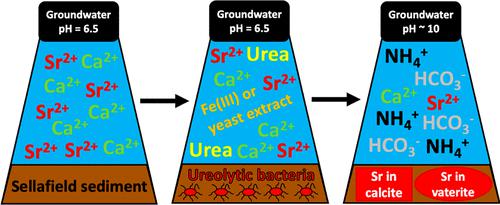当前位置:
X-MOL 学术
›
ACS Earth Space Chem.
›
论文详情
Our official English website, www.x-mol.net, welcomes your feedback! (Note: you will need to create a separate account there.)
Enhanced Strontium Removal through Microbially Induced Carbonate Precipitation by Indigenous Ureolytic Bacteria
ACS Earth and Space Chemistry ( IF 3.4 ) Pub Date : 2024-02-26 , DOI: 10.1021/acsearthspacechem.3c00252 Matthew White-Pettigrew 1, 2 , Samuel Shaw 1 , Lewis Hughes 1 , Christopher Boothman 1 , James Graham 2 , Liam Abrahamsen-Mills 2 , Katherine Morris 1 , Jonathan R. Lloyd 1
ACS Earth and Space Chemistry ( IF 3.4 ) Pub Date : 2024-02-26 , DOI: 10.1021/acsearthspacechem.3c00252 Matthew White-Pettigrew 1, 2 , Samuel Shaw 1 , Lewis Hughes 1 , Christopher Boothman 1 , James Graham 2 , Liam Abrahamsen-Mills 2 , Katherine Morris 1 , Jonathan R. Lloyd 1
Affiliation

|
Microbial ureolysis offers the potential to remove metals including Sr2+ as carbonate minerals via the generation of alkalinity coupled to NH4+ and HCO3– production. Here, we investigated the potential for bacteria, indigenous to sediments representative of the U.K. Sellafield nuclear site where 90Sr is present as a groundwater contaminant, to utilize urea in order to target Sr2+-associated (Ca)CO3 formation in sediment microcosm studies. Strontium removal was enhanced in most sediments in the presence of urea only, coinciding with a significant pH increase. Adding the biostimulation agents acetate/lactate, Fe(III), and yeast extract to further enhance microbial metabolism, including ureolysis, enhanced ureolysis and increased Sr and Ca removal. Environmental scanning electron microscopy analyses suggested that coprecipitation of Ca and Sr occurred, with evidence of Sr associated with calcium carbonate polymorphs. Sr K-edge X-ray absorption spectroscopy analysis was conducted on authentic Sellafield sediments stimulated with Fe(III) and quarry outcrop sediments amended with yeast extract. Spectra from the treated Sellafield and quarry sediments showed Sr2+ local coordination environments indicative of incorporation into calcite and vaterite crystal structures, respectively. 16S rRNA gene analysis identified ureolytic bacteria of the genus Sporosarcina in these incubations, suggesting they have a key role in enhancing strontium removal. The onset of ureolysis also appeared to enhance the microbial reduction of Fe(III), potentially via a tight coupling between Fe(III) and NH4+ as an electron donor for metal reduction. This suggests ureolysis may support the immobilization of 90Sr via coprecipitation with insoluble calcium carbonate and cofacilitate reductive precipitation of certain redox active radionuclides, e.g., uranium.
中文翻译:

通过本土尿素分解细菌微生物诱导碳酸盐沉淀增强锶去除
微生物尿解提供了通过产生碱度并产生 NH 4 +和 HCO 3 -来去除金属(包括作为碳酸盐矿物的 Sr 2+)的潜力。在这里,我们研究了英国塞拉菲尔德核电站(其中90 Sr 作为地下水污染物存在)的代表性沉积物中的原生细菌利用尿素来靶向沉积物微观世界中Sr 2+相关 (Ca)CO 3形成的潜力学习。在仅存在尿素的情况下,大多数沉积物中的锶去除得到增强,同时pH值显着增加。添加生物刺激剂醋酸盐/乳酸、Fe(III) 和酵母提取物,进一步增强微生物代谢,包括尿素分解、增强尿素分解以及增加 Sr 和 Ca 去除。环境扫描电子显微镜分析表明发生了 Ca 和 Sr 的共沉淀,有证据表明 Sr 与碳酸钙多晶型物相关。对用 Fe(III) 刺激的真实塞拉菲尔德沉积物和用酵母提取物修正的采石场露头沉积物进行了Sr K边 X 射线吸收光谱分析。经处理的 Sellafield 和采石场沉积物的光谱显示 Sr 2+局部配位环境,分别表明掺入方解石和球霰石晶体结构中。 16S rRNA 基因分析在这些培养物中鉴定出了孢子八叠球菌属的尿素分解细菌,表明它们在增强锶去除方面具有关键作用。尿素分解的开始似乎也增强了 Fe(III) 的微生物还原,可能通过 Fe(III) 和 NH 4 +之间的紧密耦合作为金属还原的电子供体。这表明尿解作用可以通过与不溶性碳酸钙共沉淀来支持90 Sr 的固定,并促进某些氧化还原活性放射性核素(例如铀)的还原沉淀。
更新日期:2024-02-26
中文翻译:

通过本土尿素分解细菌微生物诱导碳酸盐沉淀增强锶去除
微生物尿解提供了通过产生碱度并产生 NH 4 +和 HCO 3 -来去除金属(包括作为碳酸盐矿物的 Sr 2+)的潜力。在这里,我们研究了英国塞拉菲尔德核电站(其中90 Sr 作为地下水污染物存在)的代表性沉积物中的原生细菌利用尿素来靶向沉积物微观世界中Sr 2+相关 (Ca)CO 3形成的潜力学习。在仅存在尿素的情况下,大多数沉积物中的锶去除得到增强,同时pH值显着增加。添加生物刺激剂醋酸盐/乳酸、Fe(III) 和酵母提取物,进一步增强微生物代谢,包括尿素分解、增强尿素分解以及增加 Sr 和 Ca 去除。环境扫描电子显微镜分析表明发生了 Ca 和 Sr 的共沉淀,有证据表明 Sr 与碳酸钙多晶型物相关。对用 Fe(III) 刺激的真实塞拉菲尔德沉积物和用酵母提取物修正的采石场露头沉积物进行了Sr K边 X 射线吸收光谱分析。经处理的 Sellafield 和采石场沉积物的光谱显示 Sr 2+局部配位环境,分别表明掺入方解石和球霰石晶体结构中。 16S rRNA 基因分析在这些培养物中鉴定出了孢子八叠球菌属的尿素分解细菌,表明它们在增强锶去除方面具有关键作用。尿素分解的开始似乎也增强了 Fe(III) 的微生物还原,可能通过 Fe(III) 和 NH 4 +之间的紧密耦合作为金属还原的电子供体。这表明尿解作用可以通过与不溶性碳酸钙共沉淀来支持90 Sr 的固定,并促进某些氧化还原活性放射性核素(例如铀)的还原沉淀。



























 京公网安备 11010802027423号
京公网安备 11010802027423号